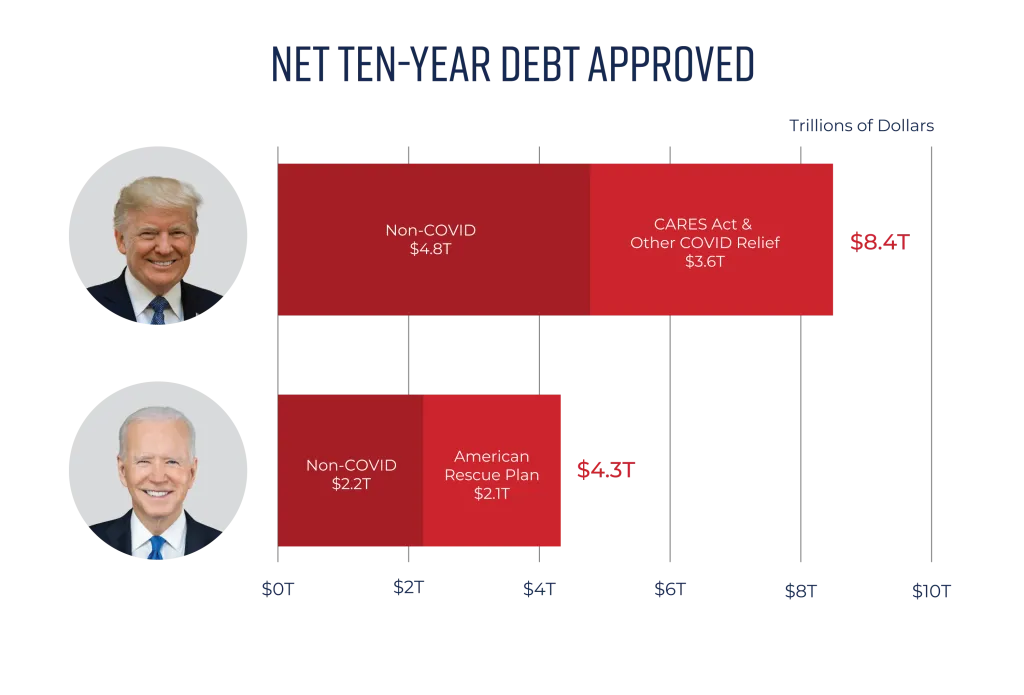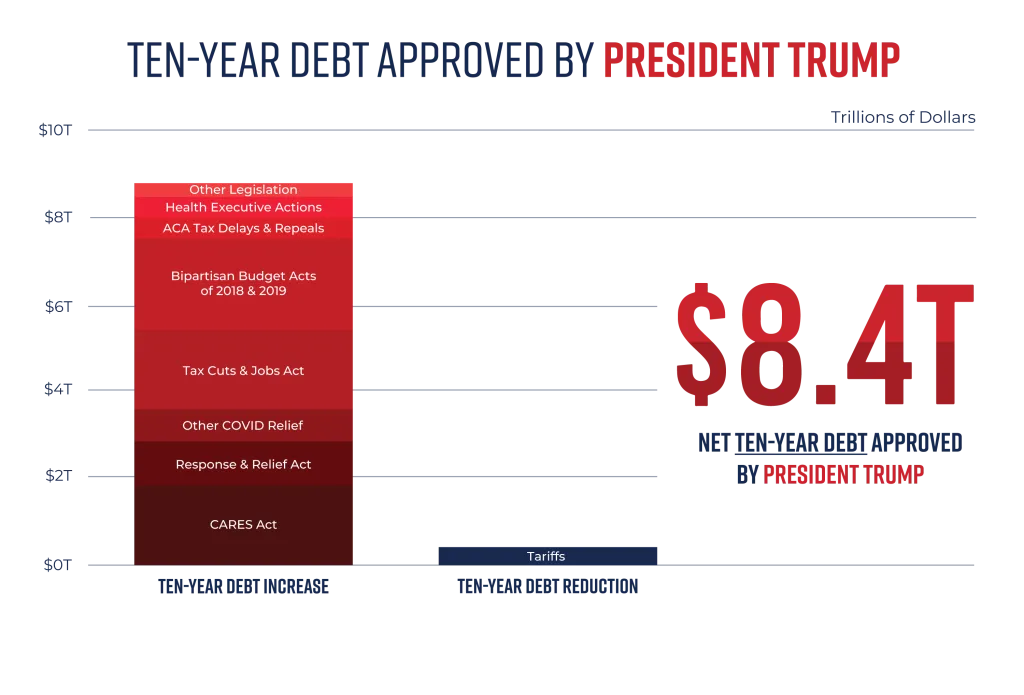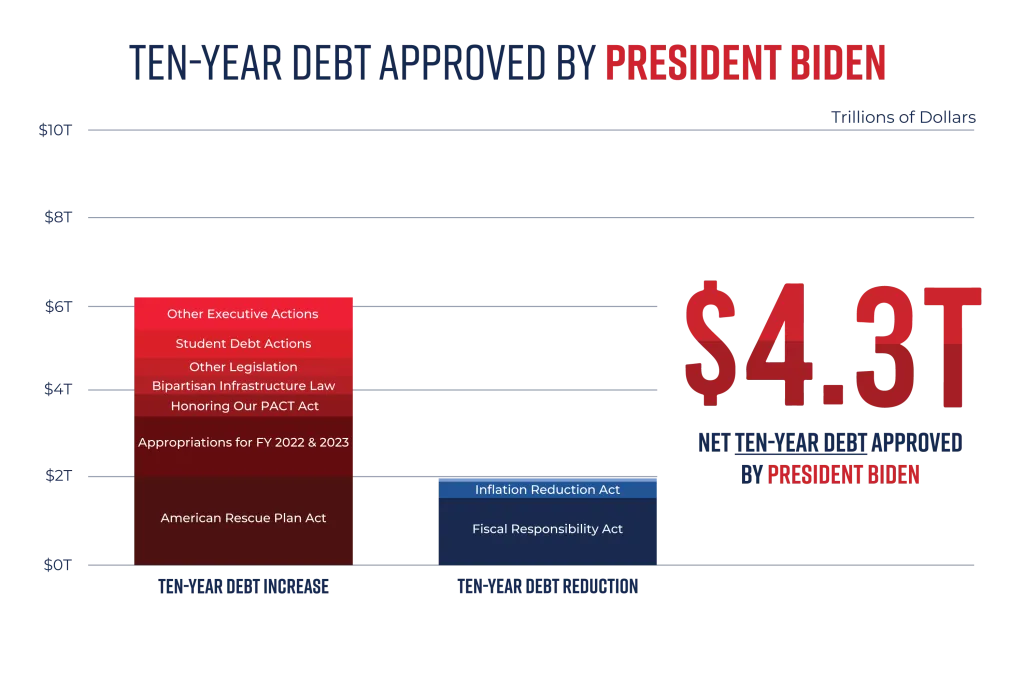Trump and Biden: The National Debt grew as spending on COVID and other things increased under both presidents. (Analysis)
by Committee for a Responsible Federal Budget
The national debt is on course to reach a record share of the economy under the next presidential administration, due in part to policies approved by Presidents Trump and Biden during their time in office, including executive actions and legislation passed by Congress.
While it is important to understand the fiscal impact of the promises candidates make on the campaign trail – particularly because they reflect the candidates’ own policy preferences and are not impacted by unexpected external events or the actions of Congress – the fact that both leading candidates have served as President also allows for a comparison of their actual fiscal records. This analysis focuses on the estimated ten-year debt impact of policies approved by Presidents Trump and Biden around the time of enactment.1 In this analysis, we find:
- President Trump approved $8.4 trillion of new ten-year borrowing during his full term in office, or $4.8 trillion excluding the CARES Act and other COVID relief.
- President Biden, in his first three years and five months in office, approved $4.3 trillion of new ten-year borrowing, or $2.2 trillion excluding the American Rescue Plan.
- President Trump approved $8.8 trillion of gross new borrowing and $443 billion of deficit reduction during his full presidential term.
- President Biden has so far approved $6.2 trillion of gross new borrowing and $1.9 trillion of deficit reduction.

| US Budget Watch 2024 is a project of the nonpartisan Committee for a Responsible Federal Budget designed to educate the public on the fiscal impact of presidential candidates’ proposals and platforms. Throughout the election, we will issue policy explainers, fact checks, budget scores, and other analyses. We do not support or oppose any candidate for public office. |
In companion analyses, we will show:
- Roughly 77 percent of President Trump’s approved ten-year debt came from bipartisan legislation, and 29 percent of the net ten-year debt President Biden has approved thus far came from bipartisan legislation. The rest was from partisan actions.
- President Trump approved $2.2 trillion of debt in his first two years in office and $6.2 trillion ($2.6 trillion non-COVID) in his second two years. President Biden approved $4.9 trillion ($2.9 trillion non-COVID) in his first two years in office and has so far approved over $600 billion of net ten-year deficit reduction since.
- President Trump approved $5.9 trillion of net spending increases including interest ($2.8 trillion non-COVID) and $2.5 trillion of net tax cuts ($2.0 trillion non-COVID). President Biden has approved $4.3 trillion of net spending increases including interest ($2.3 trillion non-COVID) and roughly $0 of net tax changes ($60 billion revenue increase non-COVID).
- Debt held by the public rose by $7.2 trillion during President Trump’s term including $5.9 trillion in the first three years and five months. Debt held by the public has grown by $6.0 trillion during President Biden’s term so far.
- President Trump’s executive actions added less than $20 billion to ten-year debt on net. President Biden’s executive actions have added $1.2 trillion to ten-year debt so far.
- The President’s budget was on average 39 days late under President Trump and 58 days late under President Biden.
Summary Table: Executive Actions & Legislation Approved by Presidents Trump & Biden
| Policy | Ten-Year Debt Impact | Partisan/Bipartisan |
|---|---|---|
| President Trump (January 20, 2017-January 20, 2021) | ||
| Tax Cuts & Jobs Act | +$1.9 trillion | Partisan |
| Bipartisan Budget Acts of 2018 & 2019 | +$2.1 trillion | Bipartisan |
| ACA Tax Delays & Repeals | +$539 billion | Bipartisan |
| Health Executive Actions | +$456 billion | Partisan (Executive Action) |
| Other Legislation | +$310 billion | Bipartisan |
| New & Increased Tariffs | -$443 billion | Partisan (Executive Action) |
| CARES Act | +$1.9 trillion | Bipartisan |
| Response & Relief Act | +$983 billion | Bipartisan |
| Other COVID Relief | +$756 billion | Bipartisan* |
| Total, Debt Impact Under President Trump | +$8.4 trillion | Partisan: +$1.9 trillion Bipartisan: +$6.5 trillion |
| President Biden (January 20, 2021-June 21, 2024) | ||
| Appropriations for FY 2022 & 2023 | +$1.4 trillion | Bipartisan |
| Honoring Our PACT Act | +$520 billion | Bipartisan |
| Bipartisan Infrastructure Law | +$439 billion | Bipartisan |
| Other Legislation | +$422 billion | Bipartisan |
| Student Debt Actions | +$620 billion | Partisan (Executive Action) |
| Other Executive Actions | +$548 billion | Partisan (Executive Action) |
| Fiscal Responsibility Act | -$1.5 trillion | Bipartisan |
| Inflation Reduction Act | -$252 billion | Partisan |
| Deficit-Reducing Executive Actions | -$129 billion | Partisan (Executive Action) |
| American Rescue Plan Act | +$2.1 trillion | Partisan |
| Total, Debt Impact Under President Biden | +$4.3 trillion | Partisan: +$3.0 trillion Bipartisan: +$1.3 trillion |
Note: bipartisan indicates legislation passed with votes from both political parties in either chamber of Congress. *Includes $23 billion of executive actions in the form of student debt payment pauses.
How Much Debt Did President Trump Approve?
During his four-year term in office, President Trump approved $8.4 trillion of new ten-year borrowing above prior law, or $4.8 trillion when excluding the bipartisan COVID relief bills and COVID-related executive actions. Looking at all legislation and executive actions with meaningful fiscal impact, the full amount of approved ten-year borrowing includes $8.8 trillion of deficit-increasing laws and actions offset by $443 billion of deficit-reducing actions.2
These estimates are based on scores of legislation and executive actions rather than retrospective estimates. Scores are generally made on a conventional basis, though the Tax Cuts and Jobs Act (TCJA) is scored dynamically. The actual debt impact of the policies was likely somewhat higher than these scores. In particular, the TCJA likely reduced revenue more than projected and saved less from repealing the individual health care mandate penalty,3 while the Employee Retention Credit was likely far more expensive than originally estimated.

Sources: CRFB estimates based on CBO and OMB projections.
The major actions approved by President Trump (and ten-year impact with interest) include:
- The Tax Cuts and Jobs Act of 2017 ($1.9 trillion debt increase)
- The Bipartisan Budget Acts of 2018 and 2019 ($2.1 trillion debt increase)
- ACA Tax Delays and Repeals ($539 billion debt increase)
- Health Executive Actions ($456 billion debt increase)
- Other Legislation ($310 billion debt increase)
- New and Increased Tariffs ($443 billion debt reduction)
- The CARES Act ($1.9 trillion debt increase)
- The Response & Relief Act ($983 billion debt increase)
- Other COVID Relief ($756 billion debt increase)
How Much Debt Has President Biden Approved?
Over his first three years and five months in office, President Biden has approved $4.3 trillion of new ten-year borrowing, or $2.2 trillion when excluding the American Rescue Plan Act. This includes $6.2 trillion of deficit-increasing legislation and actions, offset by $1.9 trillion of legislation and actions scored as reducing the deficit.
These estimates are based on scores of legislation and executive actions rather than retrospective estimates and do not include preliminary rules, unexecuted “side deals,” or actions ruled illegal by the Supreme Court. Updated scores and in-process actions would increase the total. For example, an updated estimate would likely wipe away the $252 billion of scored savings from the Inflation Reduction Act,4 the informal FRA side deals would reduce its savings by about $500 billion, and the new student debt cancellation plan could cost $250 to $750 billion.

Sources: CRFB estimates based on CBO and OMB projections.
The major actions approved by President Biden so far (and ten-year impact with interest) include:
- Appropriations for FY 2022 and 2023 ($1.4 trillion debt increase)
- The Honoring Our PACT Act ($520 billion debt increase)
- The Bipartisan Infrastructure Law ($439 billion debt increase)
- Other Legislation ($422 billion debt increase)
- Student Debt Actions ($620 billion debt increase)
- Other Executive Actions ($548 billion debt increase)
- The Fiscal Responsibility Act ($1.5 trillion debt reduction)
- The Inflation Reduction Act ($252 billion debt reduction)
- Deficit-Reducing Executive Actions ($129 billion debt reduction)
- The American Rescue Plan Act ($2.1 trillion debt increase)
Conclusion
The next presidential term will present significant fiscal challenges. While past performance is not necessarily indicative of future actions, it is helpful to examine the fiscal performance from each President’s time in office for clues as to how they plan to confront these challenges or how high of a priority fiscal responsibility will be on their agendas.
Both candidates approved substantial amounts of new borrowing in their first term. President Trump approved $8.4 trillion in borrowing over a decade, while President Biden has approved $4.3 trillion so far in his first three years and five months in office. Of course, accountability also rests with Congress as a co-equal branch of government, which passed legislation constituting the majority of the fiscal impact under both presidents.
Some of this borrowing was clearly justified, particularly in the early parts of the COVID-19 pandemic when joblessness was rising rapidly and large parts of the economy were effectively shut down. However, funding classified as COVID relief explains less than half of the borrowing authorized by either President, and arguably, a meaningful portion of this COVID relief was either extraneous, excessive, poorly targeted, or otherwise unnecessary.5
In supplemental analyses, we will compare a number of other aspects of the candidates’ fiscal records.
During the next presidential term, the national debt is projected to reach a record share of the economy, interest costs are slated to surge, the debt limit will re-emerge, discretionary spending caps and major tax cuts are scheduled to expire, and major trust funds will be hurtling toward insolvency.
Adding trillions more to the national debt will only worsen these challenges, just as both Presidents Trump and Biden did during their terms along with lawmakers in Congress. The country would be better served if the candidates put forward and stuck to plans to reduce the national debt, secure the trust funds, and put the budget on a sustainable long-term path.
[Appendices omitted, available here.]Originally published by the Committee for a Responsible Federal Budget. Republished with permission.
For more Budget & Tax News.












Your blog post was really enjoyable to read, and I appreciate the effort you put into creating such great content. Keep up the great work!